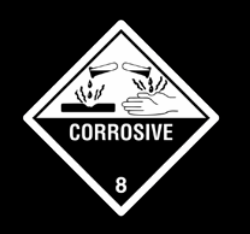This information comes from WorkSafe Tasmania's Advisory Service and the Safe Farming Tasmania team. It provides practical step-by-step guidance for safely and correctly storing and using chemicals in your small business or farm.
What do you have?
Start with a good clean up. Rationalise your existing stores, and safely dispose of empty containers and unwanted chemicals. Your local council or supplier can tell you how to do this.
Create a chemical register of your remaining chemicals. This is a record of the chemicals you have on site and their maximum possible quantities. For a template go to worksafe.tas.gov.au and search for ‘registers’.
If you have significant quantities of hazardous chemicals (for example 200 litre drums or compressed gas cylinders), give your local fire brigade a copy of your chemical register and a site plan showing storage locations and site access. This will help them make plans to handle an emergency situation at your farm or a nearby site.
Is it hazardous?
If you’re unsure whether a particular chemical is hazardous or not, look at the label. If it has a dangerous goods warning label like this below, or it says ‘keep out of reach of children’ or ‘hazardous substance’ then treat it as a hazardous chemical.

Safety info for your chemicals
Create a folder of up-to-date safety data sheets (SDS). SDS state the potential health effects of the chemicals, precautions for use, personal protective equipment, first aid, and safe handling, storage and disposal procedures.
You can get SDS from your chemical manufacturer or supplier, or through online searching. Ask your supplier to provide relevant SDS with your deliveries.
Keep SDS where workers can access them: for example, your first aid room; major storage locations (outside and undercover); and emergency shower or eyewash station. Keeping SDS in these locations also enables first aiders and emergency responders to have the information they need to provide appropriate help to an injured worker.
Keep a second set of SDS (along with chemical register and site plans) for emergency services and first responders in the farm workshop or office.
Keep your SDS current: check with the manufacturers/supplier or online to make sure they are no more than five years old.
Storing your chemicals
Keep chemicals in their original containers, with the labels intact (if the labels come off, always re-label them). Labels contain important safety warnings and guidance. If you must decant your chemicals into smaller containers, label those too. Most manufacturers/suppliers will provide you with appropriate labels.
Chemicals should be stored:
- in a ventilated, well-lit shed with solid floors and shelving. Some hazardous chemicals (particularly some dangerous goods) may require specialised storage cabinets
- with a bund or other spill containment system to contain leaks and spills
- away from food, protective clothing and equipment
- away from other incompatible chemicals (check the SDS or Australian Standard or ask your supplier for guidance). Some dangerous goods (such as flammable and oxidising compressed gases) have specified separation distances for safe storage
- away from ignition sources from heaters, grinders, battery chargers, light fittings, light and power switches, and air compressors that could produce a spark and result in a fire or explosion. These possibilities for ignition are often missed, and the potential for a serious incident goes unnoticed
- in a lockable shed secure from unauthorised access
- with access to nearby fire-fighting equipment.
If you have limited quantities of hazardous chemicals, a metal garden shed that is bunded and ventilated may suit your needs and be a practical solution. You can locate this shed away from other major buildings on your farm.
Other options include separate covered outdoors wire cages for pressurised flammable and oxidising gases in cylinders. Bunded plastic pallets are a good way to store 20 litre carboys and 200 litre drums of liquid chemicals, while reducing the risks of contaminating the ground or floor with drips/spillages.
Dealing with an incident
Work out what equipment you’ll need to deal with a spill or incident (the SDS can help). This might include an eye wash station, emergency shower, and appropriate first aid kit.
Also consider environmental factors, such as nearby stormwater channels. It may be appropriate to have a spill kit; these are available from businesses that deal in safety equipment.
Make sure your workers:
- have sufficient knowledge about safe storage and handling, by providing them with information, education, training and supervision
- are provided with and wear necessary personal protective equipment such as respirators, gloves, and chemical-resistant aprons and boots.
